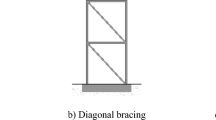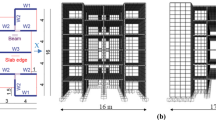Abstract
This paper examines the sensitivity of the response of optimally damped frames to uncertainty in structural and damping properties. Viscous dampers are first optimally designed for given nominal properties of the retrofitted structures and a given ensemble of records for each structure. The behavior of the retrofitted structures (in terms of the maximum envelope peak inter-story drift) considering uncertainty in their properties as well as in the dampers’ properties is then tested using Monte Carlo simulation. It is shown that the uncertainties lead to larger mean drifts than expected, and that some designs are more sensitive than others. The physical reasons for this behavior are discussed and some rules as to what designs are expected to be more sensitive are given.









Similar content being viewed by others
References
Agrawal AK, Yang JN (1999) Optimal placement of passive dampers on seismic and wind-excited buildings using combinatorial optimization. J Intell Mat Syst Struct 10(12):997–1014
Attard TL (2007) Controlling all interstory displacements in highly nonlinear steel buildings using optimal viscous damping. J Struct Eng 133(9):1331–1340
Aydin E, Boduroglu MH, Guney D (2007) Optimal damper distribution for seismic rehabilitation of planar building structures. Eng Struct 29:176–185
Ben-Haim Y (2001) Information-gap decision theory: decisions under severe uncertainty. Academic Press, London, UK
Braverman JI, Miller CA, Ellingwood BR, Naus DJ, Hofinayer CH, Bezler P, Chang TY (2001) ”Structural performance of degraded reinforced concrete members”, Paper 1178, Transactions, SMiRT 16. Washington DC
Celarec D, Dolšek M (2010) The influence of epistemic uncertainties on the seismic performance of RC frame building, paper no.534, 14ECEE, Macedonia
Chen YT, Chai YH (2011) Effects of brace stiffness on performance of structures with supplemental Maxwell model-based brace-damper systems. Earthq Eng Struct Dyn 40:75–92
Cheng FY, Pantelides CP (1988) Optimal placement of actuators for structural control. Buffalo, NCEER
Christopoulos C, Filiatrault A (2006) Principles of supplemental damping and seismic isolation. IUSS Press, Milan
Constantinou MC, Symans MD (1992) Experimental and analytical investigation of seismic response of structures with supplemental fluid viscous dampers. N. C. f. E. E. Research, Buffalo
Cristofaro MT (2009) Metodi di valutazione della resistenza a compressione del calcestruzzo di strutture in c.a. esistenti. PhD Dissertation. Università di Firenze
D’Ambrisi A, De Stefano M, Tanganelli M, Viti S (2013) Influence of the variability of concrete mechanical properties on the seismic response of existing RC framed structures. In: Lavan O, De Stefano M (eds) Geotechnical, geological and earthquake engineering 24. Springer Science + Business Media, Dordrecht (in press). doi:10.1007/978-94-007-5377-8-5-5
Dargush GF, Sant RS (2005) Evolutionary aseismic design and retrofit of structures with passive energy dissipation. Earthq Eng Struct Dyn 34(13):1601–1626
De Stefano M, Tanganelli M, Viti S (2013) On the variability of concrete strength as a source of irregularity in elevation for existing RC buildings: a case study. Bull Earthquake Eng. doi:10.1007/s10518/013-9463-2
Di Paola M, Mendola LL, Navarra G (2007) Stochastic seismic analysis of structures with nonlinear viscous dampers. J Struct Eng 133(10):1475–1478
Di Paola M, Navarra G (2009) Stochastic seismic analysis of MDOF structures with nonlinear viscous dampers. Struct Control Health Monit 16(3):303–318
FEMA 356 (2000) Prestandard and commentary for the seismic rehabilitation of buildings. Federal Emergency Management Agency, Washington
Frangopol DM, Brühwiler E, Faber MH, Adey B (eds) (2004) Life-cycle performance of deteriorating structures: assessment. design and management, ASCE (ISBN 0-7844-0707-X), Reston, Virginia, p 456
Fujita K, Yamamoto K, Takewaki I (2010) An evolutionary algorithm for optimal damper placement to minimize interstorey-drift transfer function in shear building. Earthq Struct 1(3):289–306
Fujita K, Takewaki I (2012) Robust passive damper design for building structures under uncertain structural parameter environments. Earthq Struct 3(6):805–820
Gluck N, Reinhorn AM, Gluck J, Levy R (1996) Design of supplemental dampers for control of structures. J Struct Eng 122(12):1394–1399
Hahn GD, Sathiavageeswaran KR (1992) Effect of added-damper distribution on the seismic response of buildings. Comput Struct 43(5):941–950
Henriques AA, Veiga JMC, Matos JAC, Delgado JM (2007) Uncertainty analysis of structural systems by perturbation techniques. Struct Multidiscip Optimiz 35(3):201–212
Hwang JS, Huang YN, Yi SL, Ho SY (2008) Design formulations for supplemental viscous dampers to building structures. J Struct Eng 134(1):22–31
Kala J, Kala Z (2005) Influence of yield strength variability over cross-section to steel beam load-carrying capacity. Nonlinear Anal Model Control 10(2):151–160
Kim J, Choi H et al (2003) Performance-based design of added viscous dampers using capacity spectrum method. J Earthq Eng 7(1):1–24
Lavan O, Levy R (2005) Optimal design of supplemental viscous dampers for irregular shear-frames in the presence of yielding. Earthq Eng Struct Dyn 34(8):889–907
Lavan O, Levy R (2006) Optimal peripheral drift control of 3D irregular framed structures using supplemental viscous dampers. J Earthq Eng 10(6):903–923
Lavan O, Dargush GF (2009) Multi-objective optimal seismic retrofitting of structures. J Earthq Eng 13:758–790
Lavan O, Levy R (2009) Simple iterative use of Lyapunov’s solution for the linear optimal seismic design of passive devices in framed buildings. J Earthq Eng 13(5):650–666
Levy R, Lavan O (2006) Fully stressed design of passive controllers in framed structures for seismic loadings. Struct Multidiscip Optimiz 32(6):485–498
Levy R, Lavan O (2009) Quantitative comparison of optimization approaches for the design of supplemental damping in earthquake engineering practice. J Struct Eng 135(3):321–325
Liu W, Tong M, Lee GC (2005) Optimization methodology for damper configuration based on building performance indices. J Struct Eng 131(11):1746–1756
Lopez Garcia D, Soong TT (2002) Efficiency of a simple approach to damper allocation in MDOF structures. J Struct Control 9(1):19–30
Montiel MA, Ruiz SE (2007) Influence of structural capacity uncertainty on seismic reliability of building under narroe-band motions. Earthq Eng Struct Dyn 36:1915–1934
Ohtori Y, Christenson RE, Spencer BF, Dyke SJ (2004) Benchmark control problems for seismically excited nonlinear buildings. J Eng Mech 130(4):366–385
Padgett JE, Ghosh J, Ataei N (2010) Sensitivity of dynamic response of bridges under multiple hazards to aging parameters, 19th analysis and computation specialty conference. ASCE
Park YJ, Reinhorn A M, Kunnath SK (1987) IDARC: inelastic damage analysis of frame shear-wall structures, Technical Report NCEER 87–0008
Park JH, Kim J et al (2004) Optimal design of added viscoelastic dampers and supporting braces. Earthq Eng Struct Dyn 33:465–484
Politopoulos I, Sollogoub P (2005) Vulnerability of elastomeric bearing isolated buildings and their equipment. J Earthq Eng 9(04):525–546
Politopoulos I, Pham HK (2009) Sensitivity of seismically isolated structures. Earthq Eng Struct Dyn 38(8):989–1007
Priestley MJN, Calvi GM, Kowalsky MJ (2007) Displacement-based seismic design of structures. IUSS Press, Pavia, p 721
Seidel MJ, Reinhorn AM, Park YJ (1989) Seismic damageability assessment of R/C buildings in eastern US. J Struct Eng 115(9), ASCE
Shukla AK, Datta TK (1999) Optimal use of viscoelastic dampers in building frames for seismic force. J Struct Eng 125(4):401–409
Silvestri S, Trombetti T (2007) Physical and numerical approaches for the optimal insertion of seismic viscous dampers in shear-type structures. J Earthq Eng 11(5):787–828
Singh MP, Moreschi LM (2001) Optimal seismic response control with dampers. Earthq Eng Struct Dyn 30(4):553–572
Singh MP, Moreschi LM (2002) Optimal placement of dampers for passive response control. Earthq Eng Struct Dyn 31(4):955–976
Sivaselvan MV, Reinhorn AM (2006) Lagrangian Approach to Structural Collapse Simulation. Journal of Engineering Mechanics 132(8):795–805
Sivaselvan MV, Lavan O, Dargush GF, Kurino H, Hyodo Y, Fukuda R, Sato K, Apostolakis G, Reinhorn AM (2009) Numerical collapse simulation of large-scale structural systems using an optimization-based algorithm. Earthq Eng Struct Dyn 38:655–677
Somerville P, Smith N, Punyamurthula S, Sun J (1997) Development of ground motion time histories for Phase 2 of the FEMA/SAC steel project. Report No. SAC/BD-97/04 1997
Soong TT, Dargush GF (1997) Passive energy dissipation systems in structural engineering. Wiley, London
Taflanidis AA, Beck JL (2008) An efficient framework for optimal robust stochastic system design using stochastic simulation. Comput Methods Appl Mech Eng 198(1):88–101
Takewaki I (2009) Building control with passive dampers: optimal performance-based design for earthquakes. Wiley, Singapore
Takewaki I (1997) Optimal damper placement for minimum transfer functions. Earthq Eng Struct Dyn 26(11):1113–1124
Takewaki I, Ben-Haim Y (2005) Info-gap robust design with load and model uncertainties. J Sound Vib 288(3):551–570
Taylor D (2012) Personal communication
Trombetti T, Silvestri S (2007) Novel schemes for inserting seismic dampers in shear-type systems based upon the mass proportional component of the Rayleigh damping matrix. J Sound Vib 302(3):486–526
Whittle JK, Williams MS, Karavasilis TL, Blakeborough A (2012) A comparison of viscous damper placement methods for improving seismic building design. J Earthq Eng 16(4):540–560
Wu B, Ou JP, Soong TT (1997) Optimal placement of energy dissipation devices for three-dimensional structures. Eng Struct 19(2):113–125
Yang JN, Lin S, Kim JH, Agrawal AK (2002) Optimal design of passive energy dissipation systems based on H infinity and H2 performances. Earthq Eng Struct Dyn 31(4):921–936
Zhang RH, Soong TT (1992) Seismic design of viscoelastic dampers for structural application. J Struct Eng 118(5):1375–1392
Author information
Authors and Affiliations
Corresponding author
Rights and permissions
About this article
Cite this article
Lavan, O., Avishur, M. Seismic behavior of viscously damped yielding frames under structural and damping uncertainties. Bull Earthquake Eng 11, 2309–2332 (2013). https://doi.org/10.1007/s10518-013-9479-7
Received:
Accepted:
Published:
Issue Date:
DOI: https://doi.org/10.1007/s10518-013-9479-7




